 Volosca
in 1842 - an Austrian seaport on the Adriatic coast - a painting by
August Tischbein,
Volosca
in 1842 - an Austrian seaport on the Adriatic coast - a painting by
August Tischbein, This block will be replaced by LeftMenuGaffey (orByrnes) when the page is served from a server.
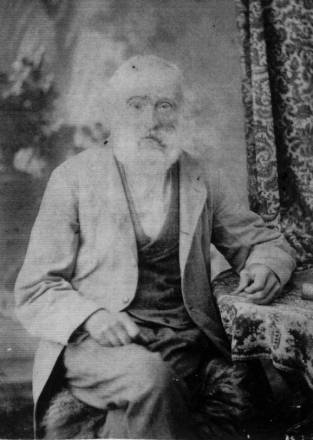
- Father:
- Captain Franciscus POBAR (1790-1837)
- Mother:
- Johanna Rajčić (1792-1855)
- Birth/baptism:
- Nov 20, 1832 in Volosca, Austria (now Croatia)[1]
- Immigration:
- to Victoria (c1851)[2]
- Occupation:
- Gold digger (1850s); farmer /butcher(1860s-1915)
- Naturalisation:
- Sep 20 1869 in Toowoomba (age 35)[3]
- Death:
- Jun 23 1915 in Toowoomba,Queensland (age 81)
- Burial:
- Jun 24 1915 in Toowoomba Cemetery (Catholic)
- AKA:
- Felix, Phillip[4]
- Marriage:
- Emma ARCHER, Oct 24 1858 at Strathfillan, Victoria (age 24)[5]
- Children:
- Felice (Felix) Francisco POBAR (Aug 30 1859- May 7, 1932)
- (Sarah) 'Grace' Johanna POBAR (Mar 18 1862-Mar 7 1942), married James Byrnes, Toowoomba, 1882
- Thomas Samuel POBAR (May 15 1864- May 7 1930)
- Emma Mary POBAR (Aug 11 1866-May 23 1951)
- Frederick William POBAR (Nov 1 1868-)
- Arthur POBAR (1872-)
- John POBAR (Sep 29 1873-
- Elizabeth POBAR (Sep 26 1877-)
A grandson of Felice's, Jack Pobar, was born in Toowoomba in 1897. He spent many hours as a youth listening to his grandfather's tales and in May, 1973, he told an interviewer that his grandfather was at the Eureka uprising... to hear Jack's story of his grandfather, click here
The young Austrian came to Australia in the early 1850s, at the time of the Victorian Gold Rushes, but no record of his arrival has been found. The story is told that Felice had earlier arrived in Singapore, signed up on a vessel, and jumped ship in Melbourne, before becoming involved in the Eureka stockade, of December 1854. Felice's death certificate in 1915 says he had been in Australia for a total of 60 years, which probably means he was in Australia around the time of the armed riot near Ballarat.
In a newspaper report in 1969, Jack Pobar, a grandson of Felice's told of his family's being in Bendigo on the goldfields in 1851[6], and in an interview now held in the Oral History section of the National Library in Canberra, he recounted Felice's activities at Eureka. [See box at right]
He was mining at Peters' Diggings in 1858 when he met his bride to be Emma Archer, the 16 year old daughter of a soldier-turned-shepherd on the property, Strathfillan. The diggings were named after David Peters, the lessee of Strathfillan station.
Gold had been found on Strathfillan late in 1857, at a time when the field at Stawell was in full swing, inducing miners from Stawell to head for the new field at Peters. Four miners extracted about 100 ounces of gold in four months, apparently a good enough result for the growth of a small township, or rather, "a big one of calico tents".[7] Peters was described as a "poor man's diggings" where small quantities of gold were relatively easily obtained (as opposed to one needing big syndicates and finance to extract it) and "everybody got a little of the precious stuff".[8] Life for the miners would have been hard, but hardly dull. According to the memories of old timers recorded some years later:
Not always so orderly, however... Only a decade later, a resident of a rival larger goldfield, nearby St. Arnaud's, recalled that in the "early days" (the period Felice was at Peters’)
And another commentator recorded that "what rivalry there was between the two existed only at a social level"
In the years after the peak of the Peters' Diggings rush, the settlement boasted a brewery and three hotels (at this time, there was a population of only 500 - possibly the hotels were small ones!).
After Peters' Diggings, the 26 year old Felice made at least one more move before heading north to Queensland. Felice took his young bride 100 kilometres south to another gold field, at Ararat, where their first child, a boy also called Felice, was born in 1859. How long they stayed there isn't known - presumably not long, because by early 1862, the family had arrived in southern Queenland, after a journey which would have taken several months by dray and cart. In Queensland, Felice worked as a labourer on a property, Jinghi Jinghi, west of Dalby, where his name was anglicised to Phillip. There, his second child, a daughter later known as Grace was born in March, 1862.
Jinghi Jinghi adjoined the famous Darling Downs property, Jimbour, which, less than 20 years earlier in 1844, saw the start of Ludwig Leichhardt's successful journey overland to Port Essington (near the present-day site of Darwin). Leichhardt's journal described the country, which four years later was to be taken up as the Jinghi Jinghi station, as "plains without trees, richly grassed, of a black soil".[11] Jimbour and Jinghi Jinghi were the largest properties in the area at the time, each of about 300,000 acres (125,000 hectares).
At the time of the arrival of the Pobar family, the lessee of the license to depasture stock on Jinghi Jinghi was W B Tooth, but the lease must not have been too profitable, for during the 10 year period up to 1865, the land saw the lease change hands no less than five times. Part of the Jinghi Jinghi property was excised from the station for the township of Jandowae, and later, large areas were thrown open to selectors of 640 and 320 acre blocks.[12]
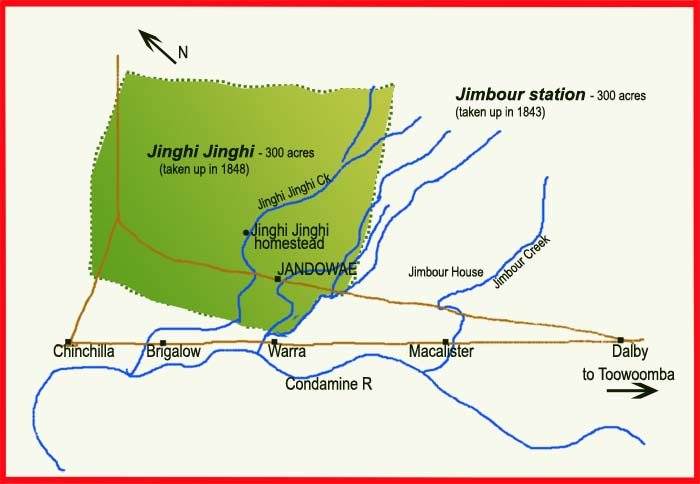
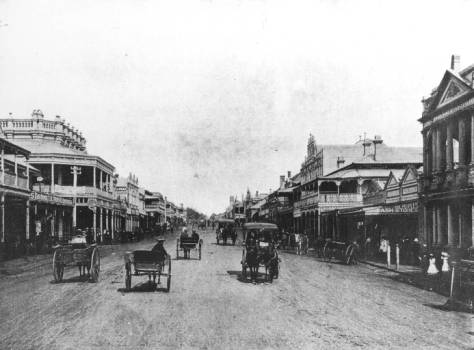
Ruthven Street, Toowoomba's main street, around 1890>
Felice became a farmer, as noted on his naturalisation records on September 20, 1869. The family later developed a retail outlet, with his eldest son Felice/Felix opening a butcher shop in Gowrie Street, Toowoomba in the 1880s. This venture came at a time before refrigeration, when meat was hung on display outside the store to catch the customer's eye ( below).
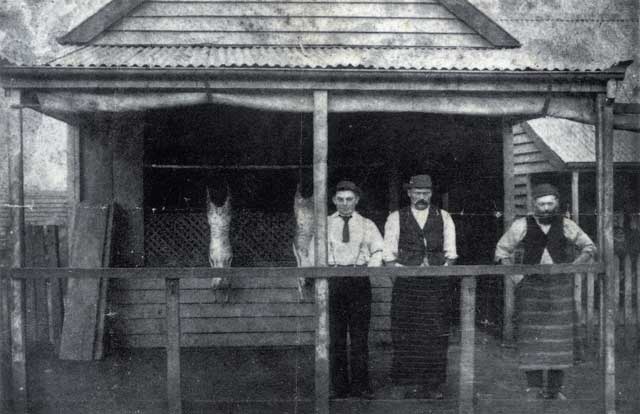
It was the start of a butcher shop group, which at one stage had as many as five stores in Toowoomba, and continued for nearly 100 years.[13]
After Emma died in 1911, Felice is said to have distributed his assets to some of his children - an action that led to some dissension in the family.
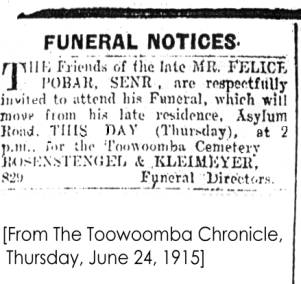
(right) Felice with his grandson Jack Pobar.
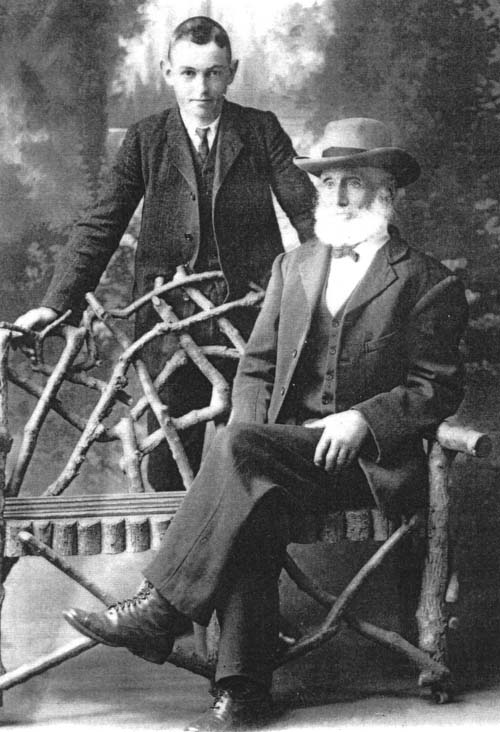
Felice was buried alongside his wife Emma (who had died nearly four years earlier) in a family plot in Toowoomba Cemetery.
[1] Volosko church baptism records .
[2] Felice's death certificate estimated that at the time of his death in 1915, he had been in Victoria 10 years, and Queensland 50 years.
[3] Qld Supreme Court naturalisation records. SCT/CF6.
[4] The spelling of Felice is used in the baptism records of Volosco church. His name change to Felix was noted on daughter Grace's marriage certificate. Felice is used in Victorian Pioneers' Index; Phillip is given in the Queensland birth certificate of daughter Grace [Sarah] which is presumably how he was known on the property Jinghi Jinghi, (near Jandowae on the Darling Downs) on which he was a labourer; Felece is how he himself signed his name on his naturalisation papers.
[5] Victorian Registrar of
Births Deaths and Marriages - Felice and Emma Archer's marriage
registration.
[6] Jack Pobar, in a letter
to the Editor of the Toowoomba Chronicle, September 9, 1969.
[7] The St. Arnaud Mercury of January 1895, (reflecting on the history of the local goldfields), compiled in Round about Kara Kara, Peters Diggings (Carapooee) by E M Barratt and J M Cameron for the St. Arnaud & District Historical Society Inc 1990.
[8] As above
[9] A letter to the editor of the Mercury, July 30, 1870, quoted in Yvonne S Palmer, Track of the Years: the Story of St. Arnaud, Melbourne University Press, 1955, p 87
[10] Yvonne S Palmer, as above, p82.
[11] Leichhardt, Dr. Ludwig, Journal of an Overland Expedition in Australia, T & W Boone, London, 1847, p5.
[12] Haselwood, Jack, Jandowae: Town and District History 1847-1988, pp2-3.
[13] Toowoomba Chronicle, August 6, 1980 gives a date of 1888, while the article on the death of Felix's son Joe, in the edition of May 2, 1984, says it was 1884